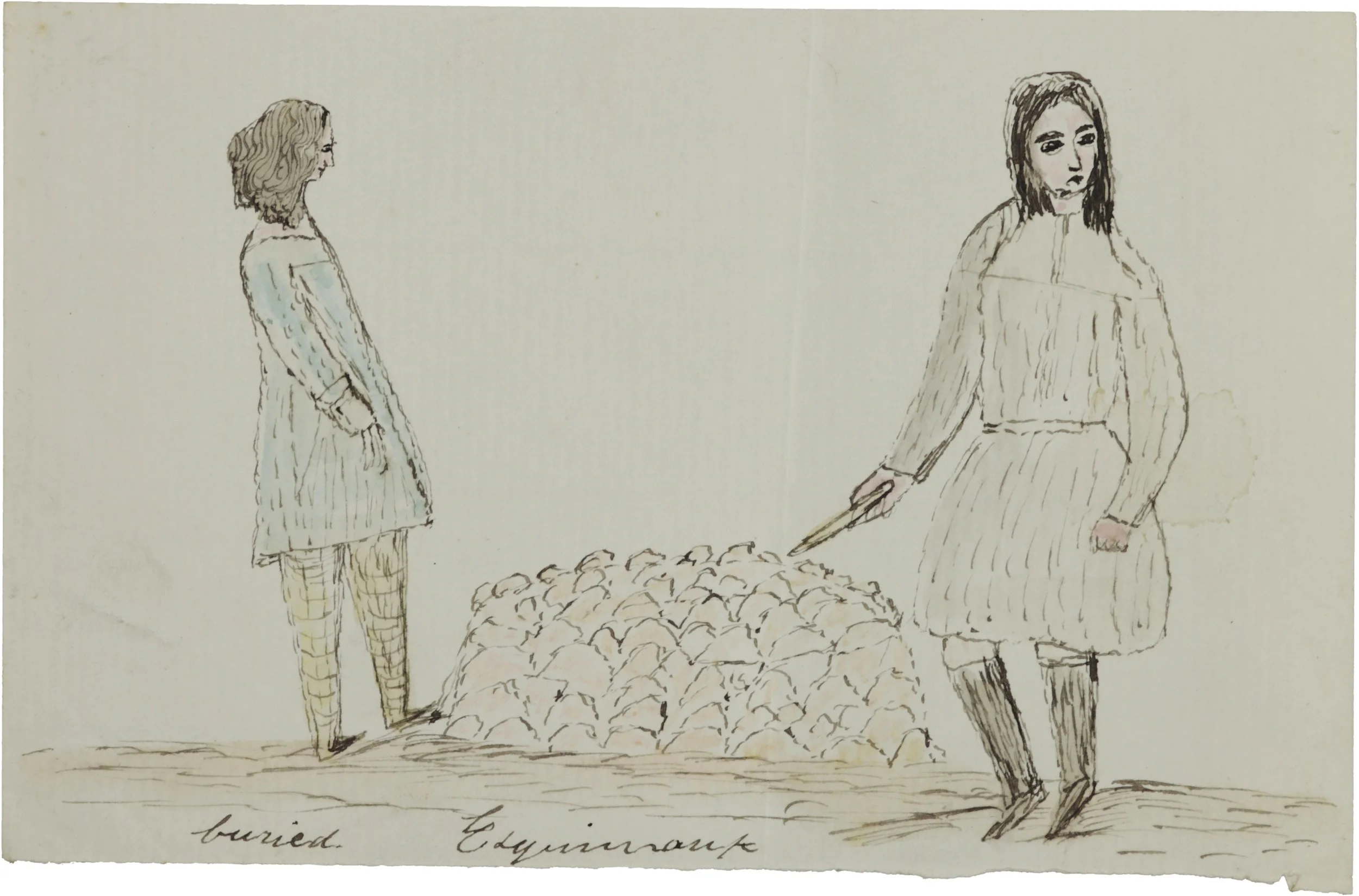Buried Esquimaux. Qalaherriaq [Erasmus Augustine Kallihirua] 1851-55. Pen and crayon on paper. 10.9 x 16.4 cm. Canterbury Cathedral Archives. CCA-U88/A/5/8/2. Reproduced courtesy of the Chapter of Canterbury
It is tempting to read resistance into Qalaherriaq's Buried Esquimaux. The drawing shows a burial ritual: we see two grieving figures standing beside a traditional burial site – a shallow or above-ground grave covered with a mound of stones, containing the deceased and their important possessions such as tools and hunting equipment. While the grave is Inughuit, the two figures are wearing European clothes.
The figure on the left has blond shoulder-length wavy hair and a somewhat feminine posture, suggesting a woman – although the trousers render this conclusion ambiguous. The figure on the right takes up more space and attention, placed in the foreground with their body and face fully facing the viewer. With tall black boots, a significantly larger face, thick eyebrows, and long black straight hair, this figure’s posture and appearance seem masculine. While the feminine figure on the left holds a handkerchief for mourning, the male figure holds a book, which may be the Bible; in the composition it fills the space between his body and the burial mound.
But whose burial mound are we looking at, who are the figures standing by it, and where is it? The unlikely combination of features suggests Qalaherriaq was not representing an actual event. Arguably it is an imagined scene that compounds time and space, combining memories from his previous life in Kalaallit Nunaat, aspects of his current situation in England, and the likelihood of his looming death.
One reading is as a post-mortem vision of Qalaherriaq's own grave being visited by two of his British acquaintances. His poor health and physical suffering in England support this interpretation – as does the inherent impossibility of the scene itself. In its staging of an improbable encounter between a British woman and an Inughuit burial mound, Qalaherriaq’s drawing seems to inhabit something of a dreamworld that is neither England nor Kalaallit Nunaat, yet somehow also both places at the same time.
Another reading is that Buried Esquimaux shows the grave of Qalaherriaq’s father. In 1850, Qalaherriaq guided Ommanney's expedition to a site along the northwest coast of Kalaallit Nunaat where his father, along with some other Inughuit and British men, had died from an epidemic the last winter. Here, Ommanney's crew looted the graves for Inughuit artefacts and, most likely, human remains, as was common practice. One of these graves contained the body of Qalaherriaq’s father.
His father’s grave was the last point of contact Qalaherriaq had with his family before leaving home for good, and it is likely that his memory of this final parting was traumatized by the explorers’ actions. If the drawing represents his father's grave, the figure to the right with long black hair may be Qalaherriaq. If so, the figure could signal his enduring Inughuit identity, which British colonialism continuously worked to remove – starting with the “civilizing act” of cutting Qalaherriaq's hair when he boarded Ommanney's vessel.
We can further understand the drawing as laying bare the devastating consequences European explorers and settlers had for Indigenous peoples in the Arctic and elsewhere.
Essay by Ingeborg Høvik and Axl Jeremiassen
Further reading
Ingeborg Høvik and Axl Jeremiassen. 2023. ‘Traces of an Arctic Voice: The Portrait of Qalaherriaq’. Interventions 25(7), 975–1003. https://doi.org/10.1080/1369801X.2023.2169626
